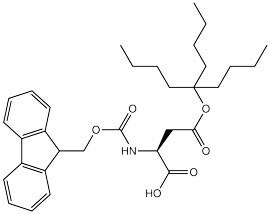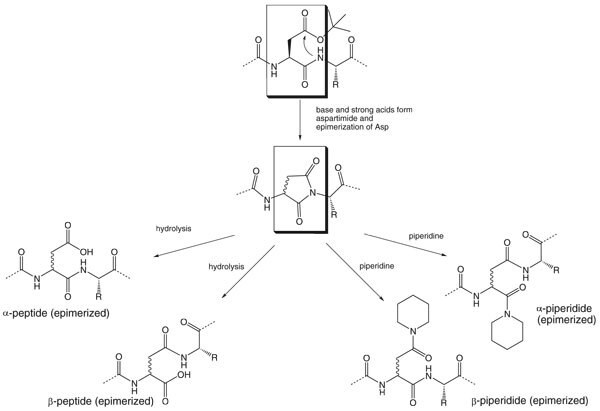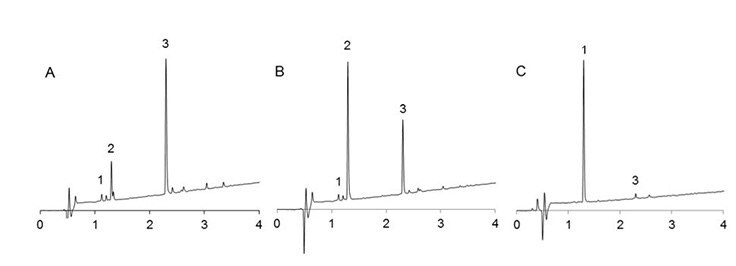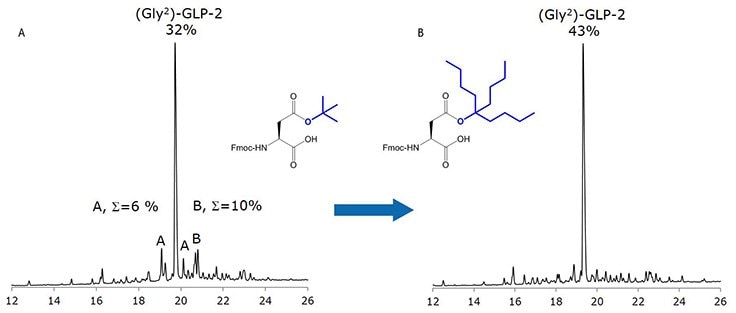Solving Aspartimide Formation in Fmoc SPPS with Fmoc-Asp(OBno)-OH
Aspartimide formation1,2 is caused by repeated exposure of aspartic acid containing sequences to bases like piperidine and can result ultimately in the generation of 9 different by-products (Figure 1)3–8. Whilst in many cases aspartimides and α- and β-piperidides generated by this side reaction may be easily separated from the target peptide by HPLC, the β-aspartyl peptides and epimerized α-aspartyl peptide are almost impossible to remove as these frequently have the same retention time as the target peptide. Furthermore, as they have the same mass as the target, the presence of these side products is hard to detect. Aspartimide formation is therefore a particularly serious consideration in the manufacturing of peptide-based APIs.

Fmoc-Asp(OBno)-OH 1 is a unique building block developed by Novabiochem® scientists that provides a simple and universal solution overcoming aspartimide formation9,10 in standard Fmoc SPPS.

Figure 1. Aspartimide formation, showing potential by-products.
Almost no aspartimide formation, even with Asp-Gly containing sequences
In comparative tests against Fmoc-Asp(OtBu)-OH and Fmoc-Asp(OMpe)-OH, using classic Scorpion toxin II peptide (VKDXYI, where X=G, N or R)11 where resin-bound peptides are treated with 20% piperidine in DMF for 200 min to simulate 100 x 2 min deprotection cycles, Fmoc-Asp(OBno)-OH gave by far the best results. For X=N and R, it reduced aspartimide formation to almost undetectable amounts (Figure 2, 3, Table 1). In the case of X=G, the most difficult situation, aspartimide formation was reduced to only 0.1%/cycle, which is negligible when one considers this is within the purity limits of commercially available N-α-Fmoc amino acids (Figure 4, Table 1).
Improved chiral stability
Aspartimides are chirally labile7, which is reflected in the high D-aspartate values observed with the scorpion toxin II peptides prepared with Asp(OtBu) and Asp(OMpe) (Table 1). D-Aspartyl peptides are often hidden contaminants of purified peptides due to their identical molecular mass and almost identical physico-chemical properties. The low D-Asp values obtained with Fmoc-Asp(OBno)-OH strongly suggest its use in peptide manufacturing processes.
Easy to couple and no alkylation products
Standard Fmoc SPPS of (Gly²)-GLP-2, a 33mer, using Fmoc-Asp(OBno)-OH delivered a crude which contained negligible aspartimide related impurities, increasing the content of target peptide by 25% compared to the standard derivative Fmoc-Asp(OtBu)-OH (Figure 5). Single one hour couplings for the two Fmoc-Asp(Bno)-OH were used. The high purity of the product indicated Fmoc-Asp(OBno)-OH coupled easily and its use did not lead to formation of any Bno-related alkylation by-products during TFA-mediated cleavage.
Table 1. Composition of crude products obtained from VKDXYI peptidyl resins after treatment with 20% Piperidine in DMF at room temperature. a Calculation of decay per cycle k: first order decay: N = N0 · e-kt → k = -ln(N)/t ; N0 = 1; t = number of cycles (100); N = area % of target peptide.

Figure 2. UPLC profiles of crude cleaved peptides VKDNYI after treatment with 20% piperidine in DMF for 18 h. 1: product; 2: D/L aspartimides; 3: D/L piperidides. A: made with Fmoc-Asp(OtBu)-OH; B: made with Fmoc-Asp(OMpe)-OH; C: made with Fmoc-Asp(OBno)-OH.

Figure 3. UPLC profiles of crude cleaved peptides VKDRYI after treatment with 20% piperidine in DMF for 18 h. 1: product; 2: D/L aspartimides; 3: D/L piperidides. A: made with Fmoc-Asp(OtBu)-OH; B: made with Fmoc-Asp(OMpe)-OH; C: made with Fmoc-Asp(OBno)-OH.

Figure 4. UPLC profiles of crude cleaved peptides VKDGYI after treatment with 20% piperidine in DMF for 18 h. 1: product; 2: D/L aspartimides; 3: D/L piperidides. A: made with Fmoc-Asp(OtBu)-OH; B: made with Fmoc-Asp(OMpe)-OH; C: made with Fmoc-Asp(OBno)-OH.

Figure 5. UPLC profiles of crude cleaved Gly-GLP-2 made with A, Fmoc-Asp(OtBu)-OH and B, Fmoc-Asp(OBno)-OH. A: D/L aspartimides; B: D/L-α/β-piperidides.
Materials
References
To continue reading please sign in or create an account.
Don't Have An Account?